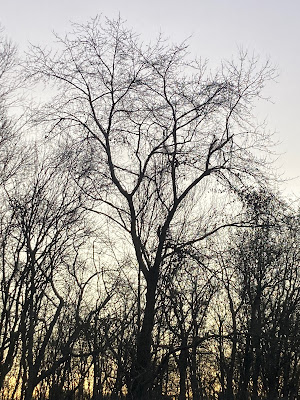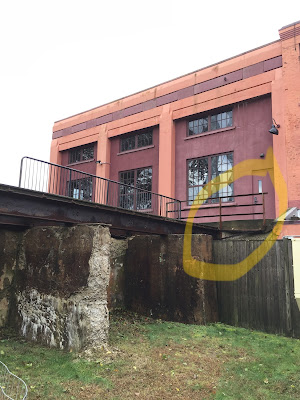Wednesday, November 30, 2022
Saturday, November 26, 2022
On Giving Thanks and Making Trees
You've likely heard - and perhaps even participated - in the debate of whether model railroading is art. But have you ever thought of it as worship or contemplation?
After being sick all this past week, and almost missing Thanksgiving entirely, I woke up this morning feeling much better and noticed the beautiful sunrise from my back deck. The mood was enhanced by some nice seasonal music playing in the background (do yourself a favor and check out this song in particular). I couldn't help but try and capture it in the photograph above and the scene reminded me of the poem by Joyce Kilmer - " . . . only God can make a tree."
 |
| I started with armatures from Scenic Express, separating them into separate "trees" and spray painting them a medium gray color. When I was young, I always colored trees brown - but, turns out, they're often mostly shades of gray. |
 |
| It's a slow process - it took me an entire afternoon to do the trees you see above - but hopefully I'll get faster with practice. |
 |
| But the results are definitely worth the time. |
Wednesday, November 23, 2022
Wednesday, November 16, 2022
Wednesday, November 9, 2022
Continuing B&M #1109 - Radiator Screen/Louvers & Air/Signal Hoses
As you may have noticed from this week's "Wordless Wednesday," I stopped by the Railroad Museum of New England (RMNE) recently to get some additional detail photos of the 1109. I was also curious to get some measurements of the sandbox grabs to see where exactly they're mounted. In my last post on this unit, I mentioned that I'd eyeballed the location of these grabs from a head-on prototype photo. Turns out, the grabs are 7" between the centerline of each leg, and the outer leg is mounted 24" from the edge of the sandbox.
I'm happy - and pretty surprised - to be able to report that I'm within an inch of all the locations/dimensions! But if you ever want to add these grabs to this model, use the actual measurements provided above.
With that inspiration fueling my motivation, I spent another nice Wednesday evening with the AML Chat group making some more progress.
Monday, November 7, 2022
Modeling Monday: More Progress on the Dickinson Witch Hazel Coal Dump
Sunday, November 6, 2022
General Layout Update - An SW1, A Coal Trestle, and Some Scenery
As I mentioned in my last post, I was a little surprised to realize I haven't done a substantive post on the layout/projects since the end of August. And if you don't follow the Valley Local Group on Facebook (and, let's be honest, why would you want to get on FB during an election season anyway), you may not realize that I've actually made some decent progress these past couple of months.
So by way of catching you up - and by way of my documenting that progress - here's what I've been up to:
If I'm a devoted New Haven prototype modeler, why am I doing a Boston & Maine SW1? If you don't know - and are curious - click here for the story.
The last time I posted about the 1109, I'd just finished disassembling and stripping it. Since then, I chiseled off all the door handles & lift rings, and added some additional detail - including my first-ever foray into stainless steel details.
Next step will likely be to install the radiator screen (which has three separate parts to laminate(!)) and then primer. Oh! And I have to add pilot detail as well (coupler lift bars, air & signal hoses). Also want to see what ChrisZ has cooked up for a suitable replacement horn (there's no Leslie A-125 in HO scale that I know of).
Dickinson Witch Hazel Power Plant Coal Dump
Sometimes the best thing for keeping up your layout motivation is to work on what you're actually in the mood to work on. I'd been getting pretty intense at the bench with the SW1, so as I was driving home from work one day, I decided to make a quick stop in Essex for some inspiration. I got it in the form of the old coal dump at Dickinson's. . .
SCENERY!
Yes, with a little help from my friends, I've even had the temerity to dive into a bit of scenery over the past bunch of weeks.
Believe it or not, the photo above is of "scenery." Well, the foamboard version of it anyway. Long-time readers may remember that I'm not much of a fan of foam base for scenery, preferring the naturally-occurring contours that result from traditional cardboard lattice & plaster cloth. But Essex is fairly flat, so it made sense to use foamboard here - but I needed help figuring out how to add the undulations. Thankfully, Bill (who, IIRC, uses foam board exclusively) agreed to come over and help me create the mess that is foamboard terraforming.
What you see above was "all" that was needed - lower the board where the road will go and rasp down the contours to match.
I'm still not sold on foamboard construction, especially when stuff like the above is necessary. Yup - that's one of the joists (actually, they're more like slats under a bedspring) that had to be cut in order to allow the board to be lowered enough. Everything went back together fine with wood glue, screws, and some PL300, but I'm glad this was the only area needing such surgery.
- Assorted talus, ballast, and cinders in the ditch along the track
- Fine ground foam and dirt on the top of the rock castings
- Random patches of static grass to break up the line between the grass that was there and the ground-up leaves
- Various colors of fine ground foam on the leaves to provide the additional color & texture of "undergrowth"
- Polyfiber, stretched as thin as possible, adhered in place with hairspray, and fine ground foam added on top (with more hairspray) to represent the brambles & thick growth leading to the treeline
- Supertrees, rattle-can sprayed gray, and various colors of SuperLeaf material added with hairspray to get a "late September/early October" look. The season I'm modeling is early Autumn - before peak color, just as the leaves are starting to turn (IMO, nobody is more effective at modeling peak color as Marty McGuirk - and I don't intend to try :^)
Now, if I can just remember how I achieved this effect, I can replicate it at the south end of Dividend - along the hillside & cut that provides the scenic divide between Dividend and Cromwell.
And that, my friends, is a great reminder of why I'm going to double-down on maintaining this blog. How else am I going to be able to archive what's worked - and what hasn't - and be able to refer back to it and jog my memory? Hopefully you'll weigh in if you see me headed for disaster - or have some advice/guidance on how to do something better, or even a new technique to try.
In the meantime, I hope you've enjoyed this update as much as I've had fun putting it together. It's neat to see that, despite how I sometimes feel about the pace, I *am* making progress. Thanks for following along!











































.jpg)










